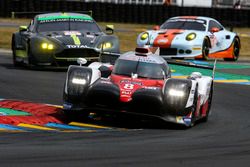Analysis: How a hot race could compromise Toyota at Le Mans
A little-known regulation dictating a maximum cockpit time for drivers in hot ambient conditions could force Toyota into modifying its planned driver stints in the Le Mans 24 Hours this year.

Photo by: JEP / Motorsport Images

















Last Monday, stewards issued a clarification to competing teams with regards to a regulation (10.10.3) governing cockpit temperatures for the race this weekend.
With weather forecasts predicting high ambient temperatures over the race weekend, teams have been reminded about regulation 10.10.3, which dictates a limitation of continuous driving time to 80 minutes when ambient temperatures reach 32°C.
This is calculated via a ‘perceived temperature’ calculation - but in reality affects only cars that are not running an air conditioning system, such as Toyota.
As well as limiting driving time to 80 minutes, drivers will have to respect a minimum rest time of 30 minutes between consecutive stints.
The official maximum ambient temperature calculation will be published two hours before the start of the race. This will predict an hour-by-hour forecast.
Should the ambient temperature reach 32°C, then Article 10.10.3 will be triggered, meaning that Toyota may be forced to adapt their driving stint strategies.
The 80-minute rule will only be applied at the start of the hour in which it is triggered, meaning that irrespective of how long a driver has been at the wheel, he can continue for an additional 80 minutes.
"The problem is that 80 minutes is right in the middle of the second stint," explained Sebastien Buemi.
"That means we will have to change drivers at every stint, and that’s a bit of a pain to be honest because you have to change the driver within the refuelling time.
"It’s possible, but it’s not easy. It’s not optimal if it’s like that. If there would not be this regulation, we would still stay as long as we should stay in the car. Three [or] four stints we would stay in the car.
"It might force us to change. The more pitstops you do, the more chances you get to have a problem; if you can do less it’s always better."
Buemi also explained that running an air conditioning system like Porsche would make the Toyota TS050 Hybrid overweight, and is therefore not a viable option.
"The weight limit is very low, it's very difficult to be on the target and you cannot afford to have cooling and stuff like this because then you would be overweight," he said. "We have a little hole, that’s it.
"We have options to have bigger openings but [the engineers] don’t like us to ask that because you lose [aero]. It’s always better to have air conditioning, but we cannot put it in because then we would be overweight."
Heat an advantage for Porsche?
While Toyota seems unprepared to sacrifice performance for cooling, LMP1 rival Porsche will adopt and maximise several methods to manage human and technical temperature during the race.
“We have passive cooling methods, which is to say ways of getting air in to the cockpit to cool the driver and hybrid system,” said Kyle Wilson-Clarke, engineer of the #1 Porsche 919 Hybrid.
“The car runs with a certain amount of blanking on the radiators, so we will be adjusting to cover off the conditions, which affects efficiency. The less you open the inlets, the less drag you are going to have, so it’s a fine balance."
Toyota and Porsche both have seven sets of slicks at their disposal for qualifying and warm-up, and a further 12 sets for the race itself.
With the individual compound windows overlapping, Wilson-Clarke emphasises the importance of getting the crossover timing correct.
“In the night-time when the conditions cool off, you have to consider the slow sectors that have been introduced for this year where the tyres have the time to cool off," he added.
"If you are on a compound which is particularly hard, in higher temperatures the tyres may lose a lot of temperature in these slow sectors,” he says.
This tyre management is especially important to the LMP1 teams, as they could adopt combined compounds together on their cars.
Controlling and maintaining the tyre temperatures properly, especially in the slow zones, could make or break individual stints, as could knowing when to change from one compound to another.
“Finding these transition points will be important and a key factor in the race, but I think in [terms of] actual compounds we are confident in knowing where Toyota are, and compared to us there isn’t a huge spread," said Wilson-Clarke.
"So it is not as if they have something completely different to us.
"We know we are in a similar ballpark [to Toyota], so I think it is more a case of using them at the right time rather than the actual compound selection we have.”
Additional reporting by Filip Cleeren
Be part of Motorsport community
Join the conversationShare Or Save This Story
Subscribe and access Motorsport.com with your ad-blocker.
From Formula 1 to MotoGP we report straight from the paddock because we love our sport, just like you. In order to keep delivering our expert journalism, our website uses advertising. Still, we want to give you the opportunity to enjoy an ad-free and tracker-free website and to continue using your adblocker.























Top Comments